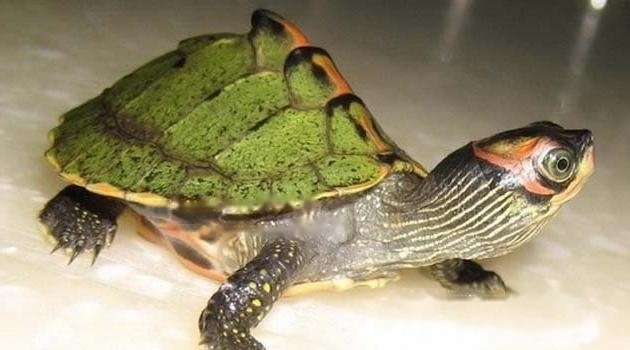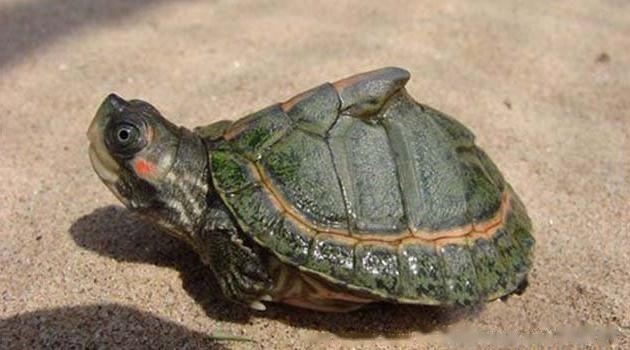The Indian leatherback turtle, also known as the Indian sawback turtle, has a towering carapace, especially the third vertebral shield. There are small black spots on the carapace, the keel in the middle of the carapace extends to the protruding tubercle of the third pentagon vertebral scutellum; the plastron is yellow, the plastron of the juvenile is orange with black spots; the top of the head is black, on the sides Yellow; black with fine yellow lines on the neck. Males and females can be distinguished by the shape of their tails. Females have shorter tails and males have thicker tails. The Indian leatherback turtle belongs to the genus Kachuga, and the towering carapace is its most obvious feature, especially the vertebral shield of the third segment is obviously towering. There are seven species, Indian Leatherback, Red Ring Sawback, Smith Leatherback, Red Crested Leatherback, Giant Leatherback, Assam Leatherback, Burmese Leatherback. In terms of Asian aquatic turtles, it is the largest genus, and there are many different views on classification.

The towering carapace, especially the vertebral shield of the third segment is obviously towering. There are small black spots on the carapace, the keel in the middle of the carapace extends all the way to the prominent tubercle of the pentagonal third vertebral shield; the plastron is yellow, the plastron of the juvenile is orange with black spots; the top of the head is black, and the sides are yellow; the neck Black with fine yellow fine lines. Discrimination between males and females: The distinction between males and females can be distinguished by their tails. Female turtles have shorter tails and male turtles are thicker. Female turtles can lay 3-5 eggs per nest, which hatch in about 80-100 days. It is best not to raise the depth of the hatchlings more than the vertical height of the hatchlings to prevent hatchlings from drowning. Indian sawback turtles vary in size, with females usually twice as large as males.
The Indian Sawback Turtle is ectothermic and so responds to changes in ambient temperature Sensitive. Its feeding and activities are all affected by the ambient temperature. Since Indian sawbacks have limited metabolic heat production, they lack the control mechanisms to retain heat production in their bodies. To overcome this shortcoming, Indian sawback turtles control daily fluctuations in body temperature by finding cool or hot places. Generally, the suitable temperature for tropical turtles is 27 to 38 degrees Celsius, and for temperate turtles, it is 20 to 35 degrees Celsius. The lethal temperature of some Indian sawback turtles is about 5 degrees Celsius outside the upper limit of the optimum temperature.

Indian sawback turtles live in large rivers and enjoy Turtles begin to hibernate when the flow is gentle or when the temperature is around 10 degrees Celsius in still water. When the temperature rises to about 15 degrees Celsius, the turtles begin to move, and some even start to eat. Generally, when the temperature is 25 degrees Celsius, the feeding and activity of turtles are set as normal values. The temperature of about 30 degrees Celsius is the best temperature for turtles to eat, move and grow. Therefore, in the middle and lower reaches of the Yangtze River in China, April to October is the feeding and activity period of turtles; November to March is the hibernation period of turtles.
Indian leatherback turtle, red-ringed sawback turtle Pink is very eye-catching. Probably the most beautiful of the high-backed turtles. Taiwan imported small batches a few years ago, but because young sawback turtles are easily infected by aquatic molds and have weak adaptability to new environments, the mortality rate within a week is as high as more than 80%. There are probably not many individuals that can be raised. When purchasing, pay special attention to whether there are symptoms of infection. It is best to raise young turtles alone first, and apply fish antifungal drugs to prevent infection, and then mix with other turtles after the adaptation period.
The environment in which Indian leatherback turtles are raised is the same as that of general terrapins. Half land, no special arrangement is required. The diet is more omnivorous, and the general aquatic turtle feed, leafy vegetables, dead fish, dead shrimp and frozen red worms, mealworms, etc. can be accepted. As long as the imported individuals are not infected, it is not difficult to raise them. Indian leatherback turtles vary in size, with females usually twice as large as males.
![[Dog Training 5] The training method of pet dog dining etiquette](/static/img/12192/12192_1.jpg)





